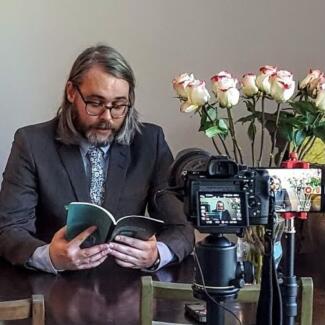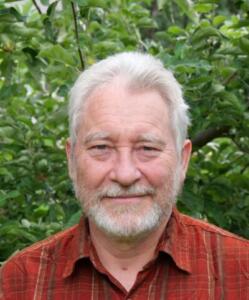1890 Love in the Quantum Age
Catalogue d’oiseaux
By Aaron Tucker
Toronto: Book*hug Press, 2021
$20.00 / 9781771666947
Reviewed by Harold Rhenisch
*
 Catalogue d’oiseaux is a long poem that portrays a pair of lovers in their forties remaking themselves into a couple, despite distance threatening to divide them.
Catalogue d’oiseaux is a long poem that portrays a pair of lovers in their forties remaking themselves into a couple, despite distance threatening to divide them.
It is the rhythmic rocking of a body in isolation, two bodies rocking together as bodies will, and waves rolling in from the sea at the edges of every line on its pages. And breaking. Each one breaks into pieces. Sometimes, it’s like reading pebbles. That is, until you hear the surf in them.
“I’ve always tried to keep my research and my writing separate,” Tucker told me, referring to his other career as an academic AI researcher. He hasn’t, luckily. Apart from being a solid long-form lyric, Catalogue d’oiseaux embodies the linguistic landscape of anyone writing for machines, which tends to be in loops the machine initiates over and over again. “The loop,” said Tucker, “is my main poetic tool.”
The integration is finely-grained. During the lovers’ brief times together over a year of separation, they travel to galleries and explore the cultural life of cities. They don’t grow particularly close to their destinations, but they do grow closer to one other as they build a new world for themselves in Frankfurt, Paris, Lisbon, New York, Toronto, Philadelphia, and Zürich.
Such travel is curious. A Torontonian born and raised in Lavington B.C., Tucker watches village after village flow past the train from Frankfurt to Mainz (for example). Each has a steeple and earns little other comment than its sameness to the others. The lived history that binds them is absent. Larger centres with strong traditions of “Art” do draw his attention. Mainz, for example, is portrayed as a city with many cathedrals, because that’s the appearance it gives, although it only has one, and many churches. The superfluous cathedrals are art. They stick up above the city’s low, everyday roofs and catch the eye.
Birds stick out of the fabric of the poem in the same way. Such birdsong also animates the melodies of the poem’s namesake, Olivier Messiaen’s Catalogue d’oiseaux (1956-8), within the body of a piano played by human fingers.
Like cities, these birds are everywhere in Tucker’s book. In a world of sameness and loops of repetition, they are where the poem holds lyrical, emotional moments—which then fly off, which then come again, with another bird, and another way of the body moving in space. Loops.
Here’s one way of looking at the poem’s genesis: Tucker was writing emails to erase the loss of separation and then translated them into poems. Here’s another loop: he transferred emotions, which he and his “nestpartner” (as he puts it) built together, as packets, just as email does with words. Here’s another: each line of this long poem is a pulse of energy, divided into two parts like a quantum particle to maintain that connection despite recurring absence. Then he does it all over again. Loops.
What a love story, though! Two quanta find themselves across the universe, neither here nor there, yet locked into place when one is observed. Suddenly, the only separation between the two lovers is a comma, a brief intake or holding of breath, no more. Such breaths happen when people look at art together or when “watching gulls flap against the sky.”
Tucker is also a novelist, so his packets aren’t emails broken up and then reassembled into messages by software. They are sentences. Each is read discretely, simultaneously by language and human bodies. Here are four of them in series, to let you see what it looks like as they make one sentence together across breakage:
“you, Harvestwoman, ‘the song’s what makes you sing’
breathe, then breathing, a waterway under patient bridges
and we trot, holding each other, the movements of the day
underskin & shared, rounded by currents of near-sleep”
You can read each one on its own, but they read best together on the edge of perception. That’s pretty cool. Until then, it’s like watching an animal pace in a cage.
With the artfulness of a pianist, Tucker is giving us his whole structure without giving away all its iterations. It keeps this long poem continually fresh. Back in the day when there were no small screens, there was talk about books like this, as interfaces, with notions of writer and reader facing a page as if the other was just on the other side of an infinitely thin skin permeable only by imagination. Tucker has updated all that.

He does so with physical environments, too. Of his early poems, Tucker said in an interview with rob mclennan, “The question I began apartments with was “How do people live in cities and not go crazy? Growing up in very rural B.C. and then moving to Toronto, I was struck by how little space and language is afforded to individuals.” That’s a common enough problem in a country on the move to urban space, and a pressing problem for physical bodies caught up in this translation. Tucker has applied a rural imagination to the problem, one rooted in reading landscapes as social relationships: “I wondered how I would keep living in the city and still maintain a vocabulary that was uncorrupted by ubiquitous advertising….”
That’s a rural observation. So is this: “…how I could carve out a gap to make a home when so many of the living spaces look the same and encroach on each other?” The same can be said of sentences. Tucker’s have no periods. It’s an effective trick, if you can get over the hump of the lines falling apart as they strike empty space and the words become data without information. Luckily, Tucker gets there. As a reader, I enjoyed taking part in this game.
To get to that world of intelligence from the claustrophobia of a concrete city, Tucker first wrote poems using a creation called Chessbard, which generated poems as chess games, which he then translated into a new medium: human language. He found their prompts surprisingly lyrical. Around this time, he wrote of Toronto like this: “On one hand there is something crushing and constant about this pressure but on the other, now that I’ve been here for 3+ years, I’ve realized these concerns and questions are also what makes me adore the city.”
Now, however, it is his lover who brings him forth into the new self that he is when they are together, as it should be:
“& I can see how you have remade me
pulled the ill-fitting & motheaten clothes of my past into firelight
now my shirt collar is crisp & tailored, pant cuffs the perfect length
your hands on my chest, smoothing & fussing
in front of our fireplace, your hand in mine.”
Simple, repetitive loops, yet through the attention they hold and release, art, a kind of multi-generational human attention and presence, stills bodily panic at alienating environments cut from the Earth, and delivers bodies into intimacy:
“interior surveillance lighting, grates underfoot
subterranean pathways, claustrophobic
terror in its construction, stripped of human personality
the flatness of bureaucratic systems
we talked through this unease, remembering Philadelphia
& the art museum’s archives, wandering through Duchamp’s papers
delighting in his thin, casual handwriting, pen barely touching the surface
we sat legs touching, studied past exhibition catalogues & handbills”
“I am more interested,” Tucker told me, “in movement than in stopping and looking.” He added, “Something I like about algorithmics and coding is the idea of the loop as a form of logic, something about returning, going away and going back — returning to places you’ve been before but you are different.”
As the book closes, he brings his lover to the Coldstream Valley in the British Columbia Interior. There, she “told [him] how hard it is to believe [he] came from this place” (a small town like the others the lovers had hurtled past in Europe). In response, he “offered to walk that block until each weedblade & pebble / sunk into your steps, until muscle memory guided you.”
This is a a book about humans remembering themselves through their bodies. And birds. Of course.
Just don’t be fooled by the space of each page, which makes the lines look like the transmission is breaking up as you cross the mountains. Their real performance space is somewhere between that page and your tongue as you sing along. And that’s the point.
*

Harold Rhenisch has written some thirty books from the Southern Interior since 1974. He won the George Ryga Prize for The Wolves at Evelyn (Brindle & Glass, 2006), a memoir of German immigrant life from the Similkameen to the Bulkley valleys. His other grasslands books are Tom Thompson’s Shack (New Star, 1999) and Out of the Interior (Ronsdale, 1993). He lived for fifteen years in the South Cariboo and has worked closely with the photographer Chris Harris on Spirit in the Grass (2008), Motherstone (2010), and Cariboo Chilcotin Coast (2016), as well as on The Bowron Lakes (2006), all published by Country Lights; and he writes the blog Okanagan-Okanogan. He is working on Commonage, a history of the Okanagan region, highlighting the American history of Father Charles Pandosy and situating the roots of the Commonage land claim in the North Okanagan in American colonial practice in Old Oregon. Editor’s note: Harold Rhenisch has recently reviewed books by Dale Tracy, Dominique Bernier-Cormier, Selina Boan, Joseph Dandurand, Délani Valin, Robert Bringhurst, Rayya Liebich, Sarah de Leeuw, Roger Farr, Stephan Torre, Don Gayton, and Calvin White for The British Columbia Review. His book Landings (Burton House, 2021) was reviewed by Luanne Armstrong; The Tree Whisperer (Gaspereau, 2021) was reviewed by Adrienne Fitzpatrick. Harold lives in Vernon.
*
The British Columbia Review
Interim Editors, 2023-24: Trevor Marc Hughes (non-fiction), Brett Josef Grubisic (fiction)
Publisher: Richard Mackie
Formerly The Ormsby Review, The British Columbia Review is an on-line book review and journal service for BC writers and readers. The Advisory Board now consists of Jean Barman, Wade Davis, Robin Fisher, Barry Gough, Hugh Johnston, Kathy Mezei, Patricia Roy, Maria Tippett, and Graeme Wynn. Provincial Government Patron (since September 2018): Creative BC. Honorary Patron: Yosef Wosk. Scholarly Patron: SFU Graduate Liberal Studies. The British Columbia Review was founded in 2016 by Richard Mackie and Alan Twigg.
“Only connect.” – E.M. Forster
9 comments on “1890 Love in the Quantum Age”
Excellent review, Harold! I love how you develop the sense of loops and the loving relationship of the couple.